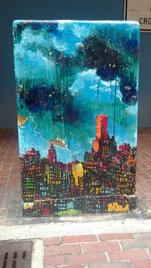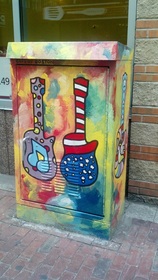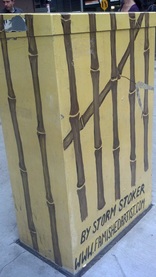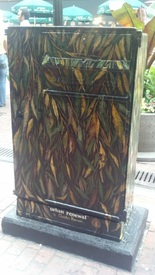Recently the Art Haus SLC launched a new program featuring local artists' work in people's living rooms called, you guessed it, Art In The Living Room. It is a wonderful program bringing members of the community together with local artists to share their work, discuss new ideas and connect with each other in a comfortable environment!
While we also plan to create many opportunities for members of the SLC community to engage with new artistic endeavors (in living rooms, classrooms, galleries, store fronts, wherever!), we also recognize that works of art are all around us; sometimes all we have to do is take a moment to notice it. That is why we are launching an interactive, mini-program documenting works of art in our different communities and sharing them online. Art In The Neighborhood will be a chance for you to recognize works of art in your area, to observe what and where they are, and to ponder why they're there, who created them and what inspired these artists. It can be anything from a wall mural, to a street band, to a school-groups' class project, to an installation at a bus stop. We ask that you to stop, wonder and share what it is you see and hear in your neighborhood.
To kick off this mini-program, I'd like to share with you a unique community arts project that started in my community about four years ago in Boston, MA, my community. Although I had walked through Downtown Crossing many times, it wasn't until I was waiting to meet friends to see a movie that I was even aware of all the art around me!
While we also plan to create many opportunities for members of the SLC community to engage with new artistic endeavors (in living rooms, classrooms, galleries, store fronts, wherever!), we also recognize that works of art are all around us; sometimes all we have to do is take a moment to notice it. That is why we are launching an interactive, mini-program documenting works of art in our different communities and sharing them online. Art In The Neighborhood will be a chance for you to recognize works of art in your area, to observe what and where they are, and to ponder why they're there, who created them and what inspired these artists. It can be anything from a wall mural, to a street band, to a school-groups' class project, to an installation at a bus stop. We ask that you to stop, wonder and share what it is you see and hear in your neighborhood.
To kick off this mini-program, I'd like to share with you a unique community arts project that started in my community about four years ago in Boston, MA, my community. Although I had walked through Downtown Crossing many times, it wasn't until I was waiting to meet friends to see a movie that I was even aware of all the art around me!
| This image to the left is actually a utility box right in the center of Downtown Crossing, a busy shopping area in the heart of Boston. I was able to use my phone to not only snap a picture, but also search the internet to find out what it was.* I discovered a program hosted by the Boston Arts Commission called the PaintBox Program. As listed on their website, "PaintBox aims to highlight local artists within their community and, in doing so, brighten up the streets and deter the vandalization of utility boxes. Through PaintBox, the Art Commission asks Boston artists to get out on the streets of their neighborhoods and help create an ongoing dialogue about art by painting utility boxes." The website includes an interactive map listing not only these PaintBox projects all throughout the city, but other public artworks. Discovering this map allowed me to find other painted utility boxes in the area. |
I now notice these painted boxes all over the city as I walk around it. Sometime I am able to check online and find out more about the artist or their process, like this artist who documented her work on her Flickr page and an article she wrote for the Examiner.com. But I can also take just a moment to wonder about this small work of art in the middle of Boston, snap a quick picture and share it with friend.
TAHSLC hopes that you will do the same. As Henry David Thoreau once said "It's not what you look at that matters, it's what you see." When you are traveling through your own community, and you come across a work of art or a performance, take a minute to Stop, Wonder and Share it with us!
Go ahead and share with us on Facebook, Twitter (@TheArtHausSLC) or in our comments section below. Or check out what other members of your community have found in their neighborhood.
Anne Wright
Co-founder of TAHSLC
TAHSLC hopes that you will do the same. As Henry David Thoreau once said "It's not what you look at that matters, it's what you see." When you are traveling through your own community, and you come across a work of art or a performance, take a minute to Stop, Wonder and Share it with us!
Go ahead and share with us on Facebook, Twitter (@TheArtHausSLC) or in our comments section below. Or check out what other members of your community have found in their neighborhood.
Anne Wright
Co-founder of TAHSLC
* For some community art projects that are paintings or sculptures, I would suggest downloading Google Goggles. You can take a picture of the artwork and through Goggles, and it searches through Google's image database to list websites where the image is listed.





 RSS Feed
RSS Feed